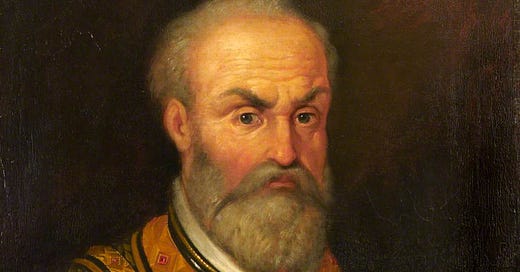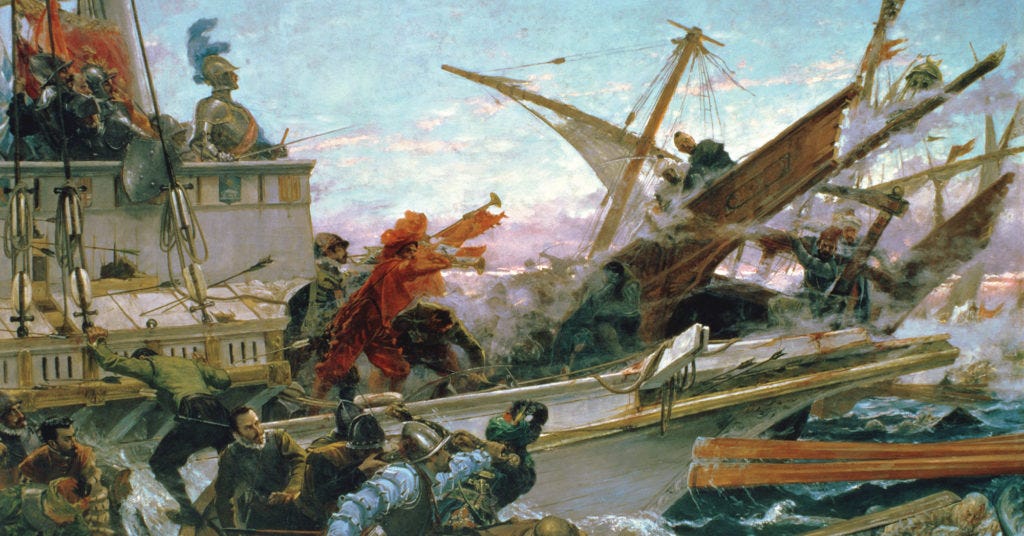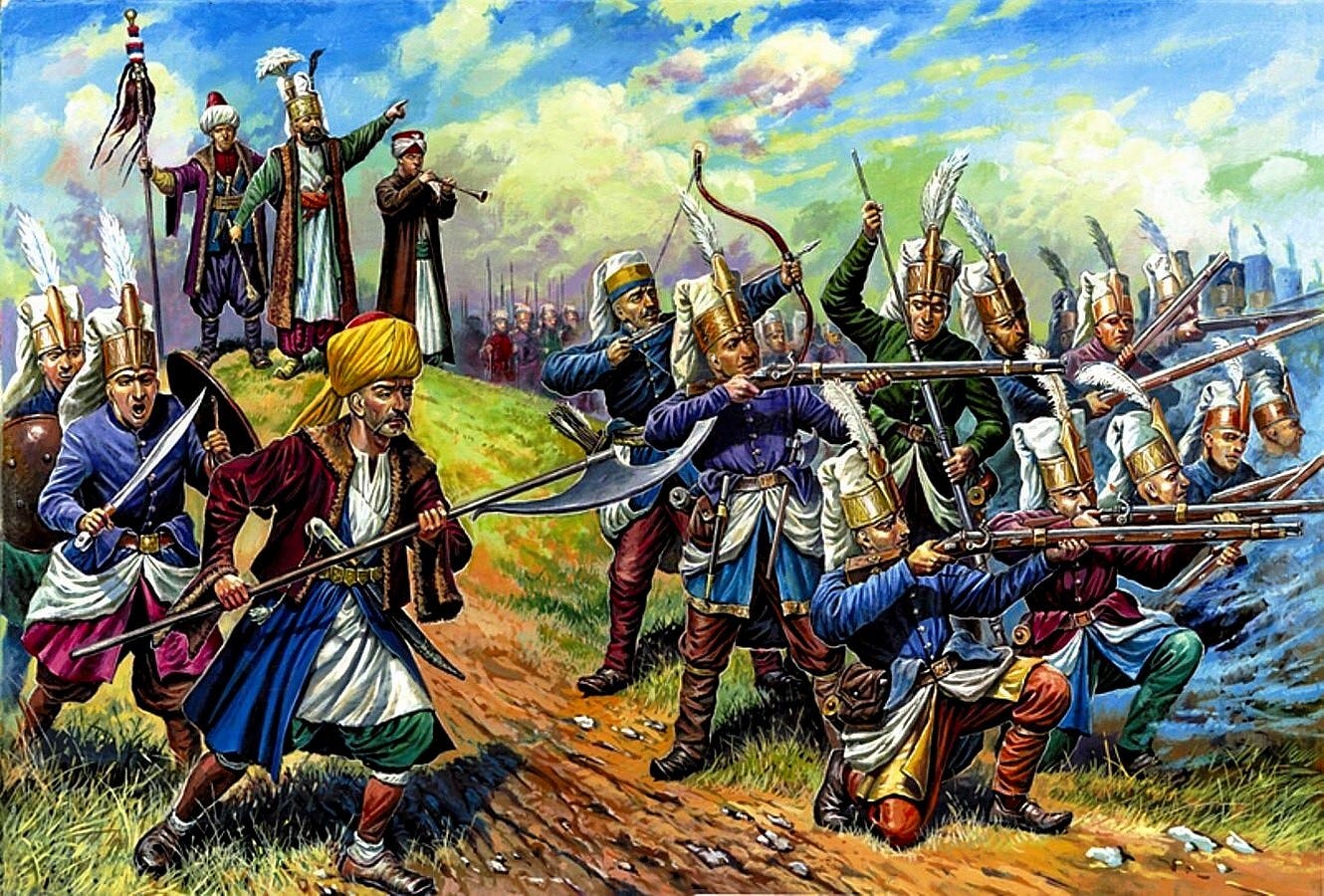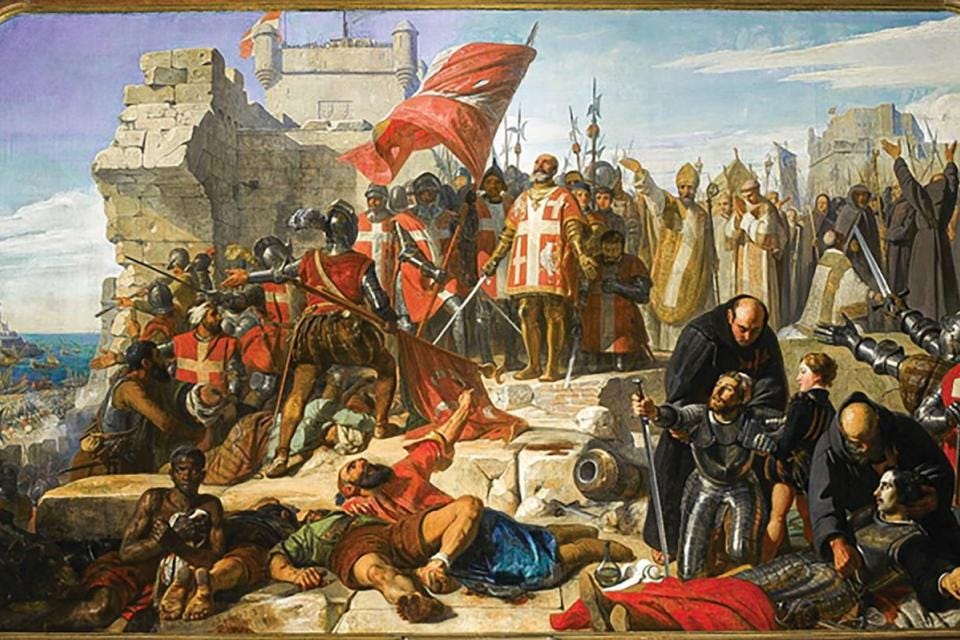Jean Parisot de la Valette, known to history as La Valette, was born to a noble family in Provence some time around 1494. He was the Grand Master of the Knights Hospitaller during the Siege of Malta in 1565, during which he commanded his men with great skill and valor against a determined enemy. His is a story worthy of remembrance, especially as it coincides with a day of great significance for Americans, September 11. The tale of events of that day over four hundred years ago will, however, require a bit of background for the modern reader.
In the midst of the European Renaissance, they were men from another age. The Order of the Knights of the Hospital of St John of Jerusalem, otherwise known as the Knights of St. John or the Hospitallers, had been in existence since the early 12th century, founded in the wave of enthusiasm that followed the success of the First Crusade. They were aristocrats from proud houses that customarily sent their sons to war, but unlike the normal chivalry of Europe, they were holy warriors, vowed to poverty and obedience, living under the combined discipline of the monastery and the barracks. Originally organized to protect pilgrims on their way to the holy land, they also administered medical care to all who sought it, in keeping with their religious vocation as warriors and monastics, killers and healers. In time, the prowess of their own and other monastic military orders like the Templars made them the backbone of the armies of the Christian Kingdom of Jerusalem, which existed in a near constant state of war with the Muslim powers that surrounded it. Eventually, they were to prove unable to hold back the tide of resurgent jihad, and to prevent the rise of the greatest power in the Middle East since the days of Darius and Xerxes, the Ottoman Turks.
Expelled from the Holy Land by the 14th century, never to return, the Knights fell back to the island of Rhodes of the southern coast of what is today Turkey. There they evolved from armored cavalry into something more suitable for their new circumstances and mastered naval warfare. Their chosen craft was the war galley, eminently suited for use in the Mediterranean; a narrow, shallow-drafted ship, it could be powered by either wind or muscle-power, and the use of oars made it highly maneuverable. A bronze ram attached to the prow made it a floating spear, and when propelled at high speed into an enemy ship, it would stave in the side of the opposing vessel, either sinking it or providing a bridgehead for boarding. The knights also made use of the most advanced technology of the age, gunpowder, and added cannons to their arsenal of crossbows and melee weapons, such as the fearsome boarding pikes which had replaced the long lances used for mounted charges. They fought the Turks at every opportunity, attacking vessel after vessel in a sustained campaign of sea-borne guerilla warfare. They were God’s own pirates, grim, extreme, and fully committed to a life of unending conflict.
Such a life appealed to fewer and fewer men as the centuries wore on, and politics in Europe turned inward. Crusading lost its luster with the loss of the Holy Land, and the power of the Turks put Christendom on the defensive. Constantinople fell, then the Balkans, then Hungary. At last, in 1522, the Hospitallers were expelled from Rhodes after a fierce battle, and were allowed by a weary Turkish army to sail away to the tiny island of Malta, which the Knights ruled as a gift from the Habsburg Emperor Charles V. The then ruler of the Turks was Suleyman the Magnificent, Sultan and Caliph, Captain of the Faithful, Sword of Allah, the man who would come to be known as the most powerful of all his predecessors and successors. He had little reason to expect any more trouble from the Order of St. John. This was not to prove the case.
La Valette had joined the Knights Hospitaller at the age of twenty, sometime around 1514. From the beginning, it was clear that he had a special devotion to the service. Present at the Siege of Rhodes, he witnessed his order’s defeat, and this seems to have inculcated in him a single-mindedness of purpose in fighting the forces of the sultan. When knights set up in Malta and recommenced their naval harassment of the Turks, La Valette was the most eager of all to join in. He became a captain in the order’s service, taking his war galley, the San Giovanni, on raid after punishing raid, even into his 30s and 40s. This was unusual, even extreme. Life at sea was brutal, filthy, highly dangerous and generally not conducive to a long life. Most knights served for only a limited number of campaigns before being given other responsibilities.
Not La Valette. Season after season, year after year, he departed from the Grand Harbor on the eastern shore of Malta and came back loaded with plunder and prisoners. He sank every Turkish ship he could find, and the sight of his vessel on the horizon soon became a cause for panic among even the elite of the North African Corsairs, the pirates who aided the sultan when it suited their purposes and simply looted anyone they could otherwise. His was an age of great Muslim seamen, and La Valette shared the waters with such masters of pillage as fearsome Barbarossa, Chuluk Ali, and the wily Turgut. In 1541, around the age of 47, La Valette was captured by the latter, and made a galley slave for a year. That he survived this was amazing in itself; such an ordeal could easily kill much younger men, and even having survived, it often destroyed one’s health forever. When he was returned in a prisoner exchange, it could have been expected that he would seek less active service, which was certainly long overdue. Another man might have been content with this.
Not La Valette. He went right back to business, raiding and destroying in God’s holy cause. His work ethic did not go unnoticed by his comrades, and La Valette was awarded a series of promotions that did eventually keep him on the island for the most part. In 1557, he reached the pinnacle of a Hospitaller’s career when his fellow knights elected him the Grand Master of the Order. Assuming command, he used his vast experience to fortify Malta for what he could see would soon come, a full-on clash with the Ottoman Empire.
The Turks had been building their navy for years, and had recently conquered Cyprus from the Venetians. In typical fashion, they skinned the Venetian commander alive and stuffed his dermis with straw, which they paraded in front of his former garrison. The knights could expect nothing less, as they had gotten bolder and bolder in their raids. In 1564, one particularly audacious captain had seized the ship of the Sultan’s chief eunuch and this insult could not go unavenged. When the reports of the spies he’d sent the Constantinople’s dockyards came in, La Valette prepared his men for the battle to come.
The Sultan sent between 30,000 and 48,000 men; the exact number is unknown. They were the best at his vast disposal, drawn from all over his empire: Sipahis, the aristocratic Turkish cavalry; the elite Janissary corps, slave soldiers torn from Christian families in the Balkans, brought up to serve the Sultan and Islam; Bektashi Dervishes, mad with hashish and fanaticism, who sought to climb to heaven on piles of dead infidels; and the corsairs, who certainly had business to settle with the knights. Along with additional levies, it was a massive and experienced force comprised of men accustomed to victory. They were commanded by Lala Mustafa Pasha, a Bosnian noted for his cruelty; it was he who had ordered the atrocities at Cyprus. Against this army, La Valette could muster around 550 knights, 2,500 soldiers sent from various nations in Europe, and 3,000 native Maltese with courage but little training, in all around 6,000 men. When the Ottoman ships appeared on the horizon, another man might have been overwhelmed by the sight.
Not La Valette. Addressing his men, he had but one thing to say-
“Today God asks for the lives you promised him.”
La Valette had poisoned the wells and pulled up the crops, but his main hope lay in reinforcements from Europe. The Hapsburg emperor Philip II, son of Charles V, had promised aid, but it would take time to assemble. Meanwhile, the knights were on their own. La Valette knew the stakes. A defeat would mean not only the destruction of his beloved order, but would give the Turks a base in the western Mediterranean from which to launch assaults on Sicily, Italy, perhaps Rome itself. Thus matters stood when the Turks landed on May 18, 1565.
One can picture the island of Malta as an elongated Pac Man, with the mouth being the Grand Harbor. On the top of the mouth was Fort St. Elmo, on the bottom were Fort St. Angelo and Fort St. Michael, from which La Valette commanded. The Turks’ initial goal was to take St. Elmo, in order to have a base from which to bombard the other forts while their men assaulted them. St. Elmo had a garrison of 1500 men, including around 100 knights. The entire might of the Turkish army descended upon it.
The knights were well prepared. La Valette had placed nearly half of his artillery in St. Elmo, and his men had long practice with it. Geography and ballistics were in their favor, as they could bring a murderous fire down on the beach with great accuracy. The bombardment that greeted the Turks was horrendous, with men blown apart as they charged the fort. Even though they secured a beach head and laid siege to St. Elmo, it was clear that it was not going to be a quick victory, and time was not on their side. Days turned into weeks as the Turks and the Knights of St. John blasted away at each other, and as the Sultan’s forces began to breach the walls, they launched charge after charge at the weary garrison. But the defenders of St. Elmo held on, fighting with superhuman strength, hand to hand with the Turks, hacking and stabbing with swords and axes, with the terrible pikes, burning men alive with flaming tar-soaked hoops. Each charge was turned back, though each time there were fewer men doing the turning.
For all their valor, the knights and the other defenders knew that the end was a foregone conclusion. La Valette needed them to buy time and they were purchasing those days with their lives. At last, after over a month of unrelenting combat, their walls were nothing but piles of rubble and every building in the fort was in ashes, except for the church. Here on the night of June 23, the men gathered for a final mass. They were all heavily wounded at this point, stabbed and burned and shot and bruised. They confessed their sins to one another and buried the chalice and serving instruments. When they left the church for the last time, those who could walk made their way to what remained of the ramparts; the others dragged chairs behind them. Propping themselves up as best they could, weapons clenched in their tired hands or resting resignedly in their laps, they awaited the final assault. The Janissaries stormed the fort and killed all but the few knights they spared for the purpose of being sent to La Valette with news of what had happened. In case this was not enough, they cut off the heads of the slain knights and nailed their bodies to crosses, which they floated across the harbor in the Grand Master’s direction. Another man might have taken this as an opportunity to sue for peace. His men had fought bravely, the 1500 defenders of Fort St. Elmo had killed some 6000 Turks, and it was probable that Mustafa would be amenable to the kind of deal the knights had gotten at Rhodes.
Not La Valette. He had his Turkish prisoners brought up from the dungeons, ordered them beheaded, loaded the heads into his largest cannon, and fired them across to St. Elmo. As the skulls of their comrades bounced off the ground around them, the Turks understood La Valette’s position. There would be no parley, no retreat, no surrender. The battle continued.
St. Angelo and St. Michael were invested soon after the fall of St. Elmo, and they were just as fiercely defended. The Turks’ every charge was beaten back with great loss to the knights but greater loss to the Sultan’s army, who still had to face the order’s superior and murderous gunnery. Eventually, on August 7, they succeeded in breaching the wall of St. Michael, and the knights and their comrades began to fall back. It now must have been clear that St. Michael would go the way of St. Elmo. Another commander would have sought to organize a strategic retreat.
Not La Valette. Seeing the unfolding rout, he threw on his helmet, took up his weapons, and charged the Ottoman line. Turk after Turk, elite Janissaries, fell beneath his well-worn sword and terrible pike. A grenade exploded near him, wounding him in the leg. The cry went up among his men that the Grand Master was in danger, and they steeled their hearts and once more threw themselves upon the Sultan’s forces with an unmatched ferocity. La Valette refused to retreat so long as the Sultan’s banner flew on his ramparts, and when told to think of his age replied:
“I am seventy-one! And how is it possible for a man of my age to die more gloriously than in the midst of my friends and brothers, in the service of God?”
Only when the Turks were repulsed did the Grand Master seek aid.
By now the position of Mustafa was precarious. It was becoming increasingly difficult to supply his men, and nearly impossible to motivate them to rush again upon those fatal walls. The summer heat was unbearable, and the poisoned wells meant that water was scarce and that disease became rampant. The knights launched sorties on the Ottoman camps, overwhelming and killing the rear-echelon guards and pillaging their food and other necessities. Finally, after months of fruitless campaigning and massive loss of life, it became clear that the army of the Sultan would have to retreat. The Turks prepared to leave on September 8th. They were unaware, however, that the relief force the knights had so long hoped for had at last arrived the day before. The Hospitallers’ tenacity had bought the time necessary for the Habsburg forces to assemble and set sail.
Don García Álvarez de Toledo y Osorio, commander of the relief, met with La Valette and coordinated an assault on the weary Turks. But this time, it would be his own men who would steal a march on their Grand Master. As in the days of old, some of his impetuous younger knights mounted horses and charged the forces of the Sultan; the Christian leaders, unwilling to let them go alone, ordered a general attack. It was a total rout. The avenging Hapsburgs and the long-suffering knights massacred their foes, driving them to the very shore. Those who could fled to the ships, which departed in disorder. Lala Mustafa Pasha was among those who had gotten away, though the victor of Cyprus could now hope for nothing but the Sultan’s customary reward for failure. Fewer than 10,000 of his men remained, and he had lost thousands of elite soldiers for essentially nothing.
The date was September 11, 1565.
La Valette was the hero of Christendom, the man who had defeated the invincible armies of the most powerful man on Earth. Money poured into Malta from all over Europe, which he used to build more imposing fortifications. They were never needed, as there would be no further attempts by the Turks to attack his island. He had sent a very clear message, that here stood a man who would defend his faith and his land from any and all who would attack it, and when it came to his enemies there was no compromise, no apologies, no euphemism or obfuscation. In recognition of a lifetime spent in the service of the Church, the Pope offered La Valette a cardinal’s hat and an estate in Rome. Another man would have jumped at the honor.
Not La Valette. He respectfully refused. He already had a job and a home.
Jean Parisot de la Valette, known to history as La Valette, passed away in 1568, lying peacefully in bed after a hunting trip. A city in Malta, Valetta, was named in his honor. Here the 49th Grand Master of the Knights of the Hospital of Saint John of Jerusalem, now most commonly known as the Knights of Malta, is buried. His epitaph reads as follows:
“Worthy of Eternal Honor, he who was once the scourge of Africa and Asia, and the Shield of Europe, whence he expelled the Barbarians by his Holy Arms”
Rest in peace La Valette, may your equal arise again, and remember September 11th.












I think I'm starting to get what you mean by Resurrection and the glory of Kings. Beautiful piece and fascinating history.
Fascinating and uplifting on this day, of all days. Truly grateful for your most apropos history lesson.